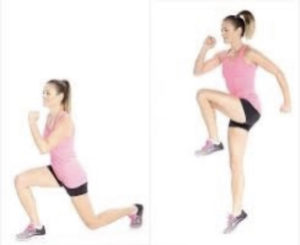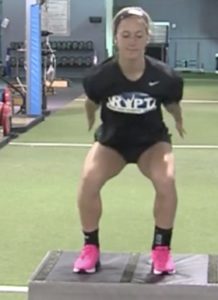Effect of Plyometric Training on Vertical Jump Performance in Female Athletes: A Systematic Review and Meta-Analysis
- PMID: 27704484
- DOI: 10.1007/s40279-016-0634-6
Abstract
Background: Plyometric training is an effective method to prevent knee injuries in female athletes; however, the effects of plyometric training on jump performance in female athletes is unclear.
Objective: The aim of this systematic review and meta-analysis was to determine the effectiveness of plyometric training on vertical jump (VJ) performance of amateur, collegiate and elite female athletes.
Methods: Six electronic databases were searched (PubMed, MEDLINE, ERIC, Google Scholar, SCIndex and ScienceDirect). The included studies were coded for the following criteria: training status, training modality and type of outcome measures. The methodological quality of each study was assessed using the physiotherapy evidence database (PEDro) scale. The effects of plyometric training on VJ performance were based on the following standardised pre-post testing effect size (ES) thresholds: trivial (<0.20), small (0.21-0.60), moderate (0.61-1.20), large (1.21-2.00), very large (2.01-4.00) and extremely large (>4.00).
Results: A total of 16 studies met the inclusion criteria. The meta-analysis revealed that plyometric training had a most likely moderate effect on countermovement jump (CMJ) height performance (ES = 1.09; 95 % confidence interval [CI] 0.57-1.61; I 2 = 75.60 %). Plyometric training interventions of less than 10 weeks in duration had a most likely small effect on CMJ height performance (ES = 0.58; 95 % CI 0.25-0.91). In contrast, plyometric training durations greater than 10 weeks had a most likely large effect on CMJ height (ES = 1.87; 95 % CI 0.73-3.01). The effect of plyometric training on concentric-only squat jump (SJ) height was likely small (ES = 0.44; 95 % CI -0.09 to 0.97). Similar effects were observed on SJ height after 6 weeks of plyometric training in amateur (ES = 0.35) and young (ES = 0.49) athletes, respectively. The effect of plyometric training on CMJ height with the arm swing was likely large (ES = 1.31; 95 % CI -0.04 to 2.65). The largest plyometric training effects were observed in drop jump (DJ) height performance (ES = 3.59; 95 % CI -3.04 to 10.23). Most likely extremely large plyometric training effects on DJ height performance (ES = 7.07; 95 % CI 4.71-9.43) were observed following 12 weeks of plyometric training. In contrast, a possibly small positive training effect (ES = 0.30; 95 % CI -0.63 to 1.23) was observed following 6 weeks of plyometric training.
Conclusion: Plyometric training is an effective form of training to improve VJ performance (e.g. CMJ, SJ and DJ) in female athletes. The benefits of plyometric training on VJ performance are greater for interventions of longer duration (≥10 weeks).
CORE Omaha Physical Therapy Explains…
By Dr. Mark Rathjen PT DPT CSCS
In the above article we see that plyo training for female athletes is very effective for jump performance in sports. This is particularity important for power sports like VB and Basketball, sprinting sports like soccer and tennis. In the more dynamic sports, force produce and vertical jump are very closely related overall. Longer duration training is more effective than short duration training as we know. 6-8 weeks alone is effective for changes in force production in all athletes as seen by other studies.
16 total studies were examined in this meta analysis, which would be considered a very strong level of evidence from a scientific point of view. We must not discount what the science is telling us when programming athletes and patients returning sot sports . The metric of drop height performance would also suggest better hip control and eccentric stability of the knee and hip. This would likely lead to a decrease risk of injury to the ACL. The ACL tear risk is already an issue for female athletes anywhere from 3-5x more likely than males. Hip strength and relative Q angle would suggest to be part of the increase in risk, and ply training should help to control that considerably.
At CORE, we do things a bit differently. We are a family owned business that treats people like family. We program our return to sports athletes much like our sports performance athletes. We make sure then go back to sports in a better condition in which they were injured.
This is who we are, this is what we do. CORE Physical Therapy in Omaha, come try the CORE difference.
C.O.R.E. Physical Therapy and Sports Performance PC,
is
owned and Operated
by
Dr. Mark Rathjen and Dr. Claire Rathjen. CORE is a family owned business that has been
established in
2015 and is proud to serve the greater Omaha metro area.
We specialize in the treatment of athletes.
For More information, Please feel free to contact us https://coreomaha.com/contact/
Please feel free to follow us at https://www.facebook.com/COREomaha/
To get started https://coreomaha.com/getting-started/
For more Blog information https://coreomaha.com/blog/
CORE Physical Therapy and Sports Performance PC.
17660 Wright St, suites 9/10
Omaha, NE 68130
402-933-4027
Similar articles
-
Does plyometric training improve vertical jump height? A meta-analytical review.Br J Sports Med. 2007 Jun;41(6):349-55; discussion 355. doi: 10.1136/bjsm.2007.035113. Epub 2007 Mar 8.PMID: 17347316 Free PMC article. Review.
-
Effects of sprint and plyometric training on muscle function and athletic performance.J Strength Cond Res. 2007 May;21(2):543-9. doi: 10.1519/R-19535.1.PMID: 17530960 Clinical Trial.
-
Olympic weightlifting training improves vertical jump height in sportspeople: a systematic review with meta-analysis.Br J Sports Med. 2016 Jul;50(14):865-72. doi: 10.1136/bjsports-2015-094951. Epub 2015 Nov 30.PMID: 26626268 Review.
-
Effects of In-Season Short-term Plyometric Training Program on Sprint and Jump Performance of Young Male Track Athletes.J Strength Cond Res. 2015 Aug;29(8):2128-36. doi: 10.1519/JSC.0000000000000860.PMID: 25647644 Clinical Trial.



